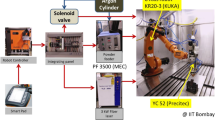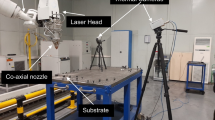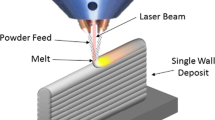Abstract
Laser-based directed energy deposition (DED) technique has the potential for precise restoration of localized damage in high value components. This paper describes the indigenous development and sub-systems integration of a robotic restoration system based on laser DED. This system comprises of four modules: a robot for imparting desired outcome; 3 kW fiber laser as the energy source; powder feeder; and a quartz block head connected deposition head with co-axial powder delivery nozzle. In addition, a damage detection technique using a laser line scanner has been developed. Experimental characterization of the developed system is also presented. Laser DED involves a complex interplay of several physical phenomena, such as powder particle injection, melt pools formation, deposition spreading, and coupled metallo-thermomechanical behavior which induces residual stresses in the deposition and the substrate. In order to understand the complete process, each of these vital mechanisms needs to be studied. Computational fluid dynamics models have been developed to predict the flow and injection of powder particles via coaxial annular nozzle, melt pool spreading and deposition geometry. The major challenge in restoration via DED is the compromised service life of the restored part due to unfavorable residual stresses originating from differential thermal expansion/contraction, volume dilation and transformation plasticity. A fully coupled metallo-thermomechanical model has been presented in this paper. The residual stresses obtained from the model have been validated using residual stress measurements from X-ray diffraction and neutron diffraction techniques. Finally, process maps have been developed based on these physics-based models to obtain optimal process parameters to ensure favorable residual stresses, dilution and geometry in DED.











Similar content being viewed by others
References
Jhavar S, Paul C P, and Jain N K, Eng Fail Anal 34 (2013) 519. https://doi.org/10.1016/j.engfailanal.2013.09.006.
Jones J B, McNutt P, Tosi R, Perry C, and Wimpenny D I, in 23rd Annual International Solid Freeform Fabrication Symposium. 2012. University of Texas, Austin, TX, USA (2012), p 821.
Liu Q, Janardhana M, Hinton B, Brandt M, and Sharp K, Int J Struct Integr 2 (2011) 314. https://doi.org/10.1108/17579861111162914.
Gao J, Folkes J, Yilmaz O, and Gindy N, Aircr Eng Aerosp Technol 77 (2005) 34. https://doi.org/10.1108/00022660510576028.
Hur J, Lee K, and Kim J, Comput Des 34 (2002) 741. https://doi.org/10.1016/s0010-4485(01)00203-2.
Jeng J -Y, and Lin M -C, J Mater Process Technol 110 (2001) 98. https://doi.org/10.1016/s0924-0136(00)00850-5.
Nowotny S, Muenster R, Scharek S, and Beyer E, Assem Autom 30 (2010) 36. https://doi.org/10.1108/01445151011016046.
Gong X, You W, Li X, and Wang L, Weld World (2020). https://doi.org/10.1007/s40194-020-00955-7.
Wen S Y, Shin Y C, Murthy J Y, and Sojka P E, Int J Heat Mass Transf 52 (2009) 5867. https://doi.org/10.1016/j.ijheatmasstransfer.2009.07.018.
Zhang A, Li D, Zhou Z, Zhu G, and Lu B, Int J Adv Manuf Technol 49 (2010) 853. https://doi.org/10.1007/s00170-010-2657-8.
Zekovic S, Dwivedi R, and Kovacevic R, Int J Mach Tools Manuf 47 (2007) 112. https://doi.org/10.1016/j.ijmachtools.2006.02.004.
Kovalev O B, Zaitsev A V, Novichenko D, and Smurov I, J Therm Spray Technol 20 (2011) 465. https://doi.org/10.1007/s11666-010-9539-3.
Tabernero I, Lamikiz A, Ukar E, De Lacalle L N L, Angulo C, and Urbikain G, J Mater Process Technol 210 (2010) 2125. https://doi.org/10.1016/j.jmatprotec.2010.07.036.
Balu P, Leggett P, and Kovacevic R, J Mater Process Technol 212 (2012) 1598. https://doi.org/10.1016/j.jmatprotec.2012.02.020.
Lin J, and Hwang B -C, Opt Laser Technol 31 (1999) 571. https://doi.org/10.1016/s0030-3992(99)00116-4.
Zhu G, Shi S, Fu G, Shi J, Yang S, Meng W, et al., Int J Adv Manuf Technol 88 (2017) 2163. https://doi.org/10.1007/s00170-016-8950-4.
Paul C P, Mishra S K, Kumar A, and Kukreja L M, Surf Coatings Technol 224 (2013) 18. https://doi.org/10.1016/j.surfcoat.2013.02.044.
Hao J, Meng Q, Li C, Li Z, and Wu D, J Manuf Process 43 (2019) 311. https://doi.org/10.1016/j.jmapro.2019.04.025.
Alya S, Vundru C, Ankamreddy B, and Singh R, Procedia Manuf 34 (2019) 695. https://doi.org/10.1016/j.promfg.2019.06.225.
Costa L, Vilar R, Reti T, and Deus A M, Acta Mater 53 (2005) 3987. https://doi.org/10.1016/j.actamat.2005.05.003.
Picasso M, Marsden C, Wagniibre J, Frenk A, and Rappaz M, A Simple but Realistic Model for Laser Cladding. n.d.
Paul S, Singh R, Yan W, Samajdar I, Paradowska A, Thool K, et al., Sci Rep 8 (2018) 14726. https://doi.org/10.1038/s41598-018-32842-z.
Koistinen D, Metallurgica RM, 1959 undefined. A general equation prescribing the extent of the austenite-martensite transformation in pure iron-carbon alloys and plain carbon steels. 8224499121 n.d.
Liu C, Ju D, International TI-I, 2002 undefined. A numerical modeling of metallo-thermo-mechanical behavior in both carburized and carbonitrided quenching processes, (2002).
Toyserkani E, Khajepour A, and Corbin S F, Laser Cladding, CRC Press, Boca Raton (2004).
Vundru C, Singh R, Yan W, Manufacturing SK-P, 2019 undefined, Non-dimensional Process Maps for Normalized Dilution Limits in Laser Direct Metal Deposition. Elsevier n.d.
Vundru C, Singh R, Yan W, and Karagadde S, J Manuf Sci Eng Trans ASME 142 (2020) 1. https://doi.org/10.1115/1.4046828.
Vundru C, Singh R, Yan W, and Karagadde S, Procedia Manuf 34 (2019) 712. https://doi.org/10.1016/j.promfg.2019.06.227.
Acknowledgements
The authors wish to gratefully acknowledge that this research was funded by the DST-Swarnajayanti Fellowship Award [DST/SJF/ETA-02/2014-2015] and Technology Systems Development Program [DST/TSG/AMT/2015/226/G], Government of India.
Author information
Authors and Affiliations
Corresponding author
Additional information
Publisher's Note
Springer Nature remains neutral with regard to jurisdictional claims in published maps and institutional affiliations.
Rights and permissions
About this article
Cite this article
Alya, S., Vundru, C., Ankamreddy, B. et al. Development and Modeling of a Robotic Restoration System Based on Laser Directed Energy Deposition. Trans Indian Inst Met 74, 1219–1230 (2021). https://doi.org/10.1007/s12666-020-02151-z
Received:
Accepted:
Published:
Issue Date:
DOI: https://doi.org/10.1007/s12666-020-02151-z




